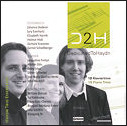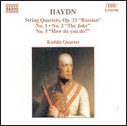 2009 is the bicentenary of the death of Joseph Haydn and to mark the occasion the Haydn Festival Eisenstadt (seat of Haydn’s patrons the Esterhazy family) commissioned piano trios by 18 composers for the festival’s resident ensemble, the Haydn Trio Eisenstadt. While D2H -Dedicated To Haydn (Capriccio 7020) is described as a “global composition project”, it is in fact quite Euro - and more particularly - Austro-centric, with 6 composers from Austria, 6 more from Europe (U.K., Spain, Belgium, Germany, Hungary and France) and 6 from the rest of the world (China, Japan, U.S.A., South Africa, Argentina and Australia). Canada is included in a peripheral way – South African composer Bongani Ndodana-Breen, who spent a number of years in Toronto as director of Musica Noir, contributed Two Nguni Dances to the collection. As well as geographical spread, there is also a broad spectrum of ages represented here with birth years ranging from 1926 (Betsy Jolas) to 1976 (Gernot Schedlberger). With almost three hours of diverse offerings, this multi-disc set kept me busy for most of the month. The range of styles is vast, from quite conservative works by John Woolrich and Xiaogang Ye to the thoroughly modern from José Maria Sánchez-Verdù, Màrton Illès and Elisabeth Harnik, with plenty of adventures in between. Although there is a dearth of biographical information, each of the pieces does have a note by the composer explaining the (sometimes quite tenuous) link to Haydn. But I also enjoyed listening “blind” as it were, trying to guess how the music related to the master, or which part of the world the composer was from, sometimes with quite erroneous results. For instance I knew there was a piece by an Australian composer, so when I heard something that to my ear was reminiscent of the Aboriginal-inspired music of Peter Sculthorpe I had an “ah ha” moment. It turned into a “ha ha” though when I checked to find I was actually listening to KAGETSU – Etude on the name of Haydn by Yui Kakinuma (Japan). Mind you when I did get to Australian Elena Kats-Chenin’s Calliope Dreaming its repetitive dance-like motifs again sent my thoughts “down under” notwithstanding the fact that all the themes were evidently drawn from Haydn’s “Mourning Symphony” and the composer spent the first half of her life in Uzbekistan. The music that is most obviously reminiscent of Haydn came from two composers known for their humour, American William Bolcom and German Dieter Schnebel. Bolcom’s HAYDN GO SEEK pays homage to some of Haydn’s famous rondos and in the words of the composer intends to “play a constant game of surprise throughout, in as Haydnesque a fashion as I could muster from two centuries remove.” Schnebel is known for his theatrics and in a reverse take on the “Surprise Symphony” the first sounds we hear are the footsteps of the musicians and a few offstage notes as they approach the performance area. What follows is a de-construction of the finale from Haydn’s string quartet “The Joke” (Op.33, No.2) replete with spiccato bowing in the violin, pizzicato from the cello, pointillist piano chording and intermittent hissing and shushing from all concerned. Other tracks of note include Lalo Schifrin’s lush and lilting (and somewhat deceptively titled) Elegy and Meditation and Ah Haydn by Betsy Jolas. This last was of particular interest to me as I had been impressed by several of this French composer’s works in my formative years, but had not encountered any of her music in more than three decades. I was pleased to note that she is still active and that her music has not lost its edge. The Haydn Trio Eisenstadt was founded in 1992 and the current membership has been in place for just over a decade. As well as their residency at the Haydn Festival they have a very busy and successful recording career, with complete recordings of Haydn’s folksong arrangements (18 CDs on the Brilliant label) and the complete piano trios of Haydn, Schubert, Mozart and Beethoven. “Dedicated To Haydn” is their second foray into the realm of the contemporary and quite an extensive one at that. Kudos to all concerned.
2009 is the bicentenary of the death of Joseph Haydn and to mark the occasion the Haydn Festival Eisenstadt (seat of Haydn’s patrons the Esterhazy family) commissioned piano trios by 18 composers for the festival’s resident ensemble, the Haydn Trio Eisenstadt. While D2H -Dedicated To Haydn (Capriccio 7020) is described as a “global composition project”, it is in fact quite Euro - and more particularly - Austro-centric, with 6 composers from Austria, 6 more from Europe (U.K., Spain, Belgium, Germany, Hungary and France) and 6 from the rest of the world (China, Japan, U.S.A., South Africa, Argentina and Australia). Canada is included in a peripheral way – South African composer Bongani Ndodana-Breen, who spent a number of years in Toronto as director of Musica Noir, contributed Two Nguni Dances to the collection. As well as geographical spread, there is also a broad spectrum of ages represented here with birth years ranging from 1926 (Betsy Jolas) to 1976 (Gernot Schedlberger). With almost three hours of diverse offerings, this multi-disc set kept me busy for most of the month. The range of styles is vast, from quite conservative works by John Woolrich and Xiaogang Ye to the thoroughly modern from José Maria Sánchez-Verdù, Màrton Illès and Elisabeth Harnik, with plenty of adventures in between. Although there is a dearth of biographical information, each of the pieces does have a note by the composer explaining the (sometimes quite tenuous) link to Haydn. But I also enjoyed listening “blind” as it were, trying to guess how the music related to the master, or which part of the world the composer was from, sometimes with quite erroneous results. For instance I knew there was a piece by an Australian composer, so when I heard something that to my ear was reminiscent of the Aboriginal-inspired music of Peter Sculthorpe I had an “ah ha” moment. It turned into a “ha ha” though when I checked to find I was actually listening to KAGETSU – Etude on the name of Haydn by Yui Kakinuma (Japan). Mind you when I did get to Australian Elena Kats-Chenin’s Calliope Dreaming its repetitive dance-like motifs again sent my thoughts “down under” notwithstanding the fact that all the themes were evidently drawn from Haydn’s “Mourning Symphony” and the composer spent the first half of her life in Uzbekistan. The music that is most obviously reminiscent of Haydn came from two composers known for their humour, American William Bolcom and German Dieter Schnebel. Bolcom’s HAYDN GO SEEK pays homage to some of Haydn’s famous rondos and in the words of the composer intends to “play a constant game of surprise throughout, in as Haydnesque a fashion as I could muster from two centuries remove.” Schnebel is known for his theatrics and in a reverse take on the “Surprise Symphony” the first sounds we hear are the footsteps of the musicians and a few offstage notes as they approach the performance area. What follows is a de-construction of the finale from Haydn’s string quartet “The Joke” (Op.33, No.2) replete with spiccato bowing in the violin, pizzicato from the cello, pointillist piano chording and intermittent hissing and shushing from all concerned. Other tracks of note include Lalo Schifrin’s lush and lilting (and somewhat deceptively titled) Elegy and Meditation and Ah Haydn by Betsy Jolas. This last was of particular interest to me as I had been impressed by several of this French composer’s works in my formative years, but had not encountered any of her music in more than three decades. I was pleased to note that she is still active and that her music has not lost its edge. The Haydn Trio Eisenstadt was founded in 1992 and the current membership has been in place for just over a decade. As well as their residency at the Haydn Festival they have a very busy and successful recording career, with complete recordings of Haydn’s folksong arrangements (18 CDs on the Brilliant label) and the complete piano trios of Haydn, Schubert, Mozart and Beethoven. “Dedicated To Haydn” is their second foray into the realm of the contemporary and quite an extensive one at that. Kudos to all concerned.
 The Capriccio label mentioned above is distributed by Naxos and it is to the Naxos catalogue that I tend to turn when I find a glaring hole in my collection. For instance although I have several dozen Haydn string quartets, when I wanted to listen to “The Joke” as referenced by Dieter Schnebel I found I did not have a recording. As I suspected it was easy to track it down. Haydn’s “Russian” String Quartets Op.33 are available in fine performances by the Kodàly Quartet on two CDs (Naxos 8.550788 & 8.550789) and once again I was able to fill in a gap in my collection without breaking the bank. It is not just the affordable prices and good to very good performances that make the Naxos line attractive to me, but even more important is the fact that their ever-expanding and ever-more adventurous catalogue is already complete when it comes to the standard repertoire and that everything stays in the catalogue and remains readily available. It is no wonder that Naxos has become the most successful purveyor of classical music of our time.
The Capriccio label mentioned above is distributed by Naxos and it is to the Naxos catalogue that I tend to turn when I find a glaring hole in my collection. For instance although I have several dozen Haydn string quartets, when I wanted to listen to “The Joke” as referenced by Dieter Schnebel I found I did not have a recording. As I suspected it was easy to track it down. Haydn’s “Russian” String Quartets Op.33 are available in fine performances by the Kodàly Quartet on two CDs (Naxos 8.550788 & 8.550789) and once again I was able to fill in a gap in my collection without breaking the bank. It is not just the affordable prices and good to very good performances that make the Naxos line attractive to me, but even more important is the fact that their ever-expanding and ever-more adventurous catalogue is already complete when it comes to the standard repertoire and that everything stays in the catalogue and remains readily available. It is no wonder that Naxos has become the most successful purveyor of classical music of our time.



